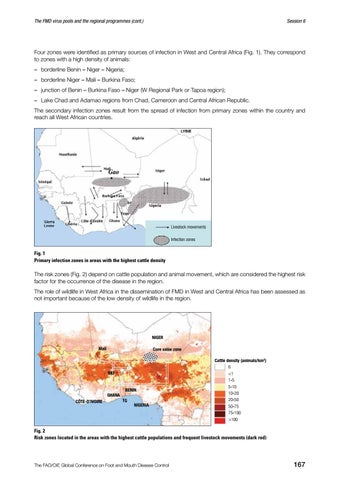The FMD virus pools and the regional programmes (cont.)
Session 6
Four zones were identified as primary sources of infection in West and Central Africa (Fig. 1). They correspond to zones with a high density of animals: – borderline Benin – Niger – Nigeria; – borderline Niger – Mali – Burkina Faso; – junction of Benin – Burkina Faso – Niger (W Regional Park or Tapoa region); – Lake Chad and Adamao regions from Chad, Cameroon and Central African Republic. The secondary infection zones result from the spread of infection from primary zones within the country and reach all West African countries.
Livestock movements Infection zones
Fig. 1 Primary infection zones in areas with the highest cattle density
The risk zones (Fig. 2) depend on cattle population and animal movement, which are considered the highest risk factor for the occurrence of the disease in the region. The role of wildlife in West Africa in the dissemination of FMD in West and Central Africa has been assessed as not important because of the low density of wildlife in the region.
NIGER Mali
Cure salée zone
BKF
BENIN GHANA CÔTE-D’IVOIRE
TG NIGERIA
Cattle density (animals/km2) 0 <1 1-5 5-10 10-20 20-50 50-75 75-100 >100
Fig. 2 Risk zones located in the areas with the highest cattle populations and frequent livestock movements (dark red)
The FAO/OIE Global Conference on Foot and Mouth Disease Control
167
















